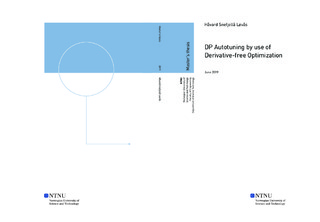| dc.contributor.advisor | Skjetne, Roger | |
| dc.contributor.author | Løvås, Håvard Snefjellå | |
| dc.date.accessioned | 2019-10-26T14:04:48Z | |
| dc.date.available | 2019-10-26T14:04:48Z | |
| dc.date.issued | 2019 | |
| dc.identifier.uri | http://hdl.handle.net/11250/2624699 | |
| dc.description.abstract | Denne avhandlingen presenterer utviklingen av en autonom tuningmetode for en dynamisk posisjoneringskontroller. Metoden er implementert i Marine Cybernetics Laboratory (MC-Lab) på 1:90-modellen av et dynamisk posisjoneringsfartøy, C/S Inocean Cat I Drillship (CSAD).
For å utlede et dynamisk posisjoneringssystem for CSAD, etableres en simuleringsverifiseringsmodell med 3 frihetsgrader av fartøyet og et bevegelseskontrollsystem for banefølging. Bevegelseskontrollsystemet inkluderer proposjonal-integral-derivatkontrolleren (PID-kontroller) som er ansvarlig for å beregne nødvendige krefter og momenter for å følge banen. Det er denne komponenten av dynamisk posisjoneringssystemet som skal tunes, og kontrollparametrene er etablert som tuningsvariablene i autotuningen.
Simuleringsverifiseringsmodellen og bevegelseskontrollsystemet brukes til å etablere utgjør til sammen simulerings-
modellen. Den brukes til å undersøke ulike typer ytelsesindikatorer for å evaluere kontrollparametrene til PID-kontrolleren. Med kontrollparametrene som optimaliseringsvariabler og ytelsen som en objektivfunksjon, blir gradientfrie optimaliseringsalgoritmer sammenlignet og evaluert. Integralet av absolutt feil er valgt som ytelsesindikator og partikkelsvermoptimalisering som gradientfri optimaliseringsalgoritme for den praktiske implementeringen.
En 2-trinns, transient manøver med bevegelser i 3 frihetsgrader er definert som banesporingstesten i MC-Lab. Denne testen brukes til å evaluere ytelsen i autotuningen. Autotuning- funksjonaliteten er implementert i Simulink og er modifisert for å fungere i sanntid. Det implementerte systemet er i stand til å gjøre autonom tuning av kontrollparametrene uten menneskelig innblanding gitt at det ikke er noen eksterne feil. Videre gjøres autotuning av PID-kontrolleren i to sjøtilstander, en i rolig vann og en i moderate bølger. Resultatet er en banesporing med maksimale posisjonsfeil under 1 cm og maksimale kursfeil under 0.5 grader. | |
| dc.description.abstract | This thesis presents the development of an autonomous tuning methodology for a Dynamic Positioning (DP) controller. The method is implemented in the Marine Cybernetics Laboratory (MC-Lab) on the 1:90 model of a DP vessel, the C/S Inocean Cat I Drillship (CSAD).
To derive a DP system for the CSAD, a 3 Degrees of Freedom (DOF) model of the vessel and a motion control system for trajectory tracking is established. The motion control system includes the proportional-integral-derivative (PID) controller that is responsible for calculating the necessary forces and moments for following the trajectory. It is this component of the DP system that is the subject of tuning, and the control parameters are established as the tuning variables.
The 3 DOF model and the motion control system are used to establish the simulation model. The simulation model is used to investigate different types of performance indicators to evaluate the control parameters of the PID controller. With the control parameters as optimization variables and a performance indicator (PI) as an objective function, derivative-free optimization (DFO) algorithms are compared and evaluated. The integral of absolute error (IAE) is selected as the PI and the particle swarm optimization (PSO) as the DFO algorithm for the practical implementation.
A 2-step, 3 DOF transient maneuver is defined as the trajectory tracking test in MC-Lab. This test is used to evaluate the performance in the autotuning. The autotuning functionality is implemented in Simulink and is modified to function in real-time. The implemented system is able to do autonomous tuning of the control parameters without human intervention for multiple hours. Moreover, autotuning of the PID controller is done in two environmental conditions, one in calm water and one in moderate/rough waves. The result is a trajectory tracking with maximal positional errors below 1 cm and maximal heading errors below 0.5 degrees. | |
| dc.language | eng | |
| dc.publisher | NTNU | |
| dc.title | DP autotuning by use of derivative-free optimization | |
| dc.type | Master thesis | |
